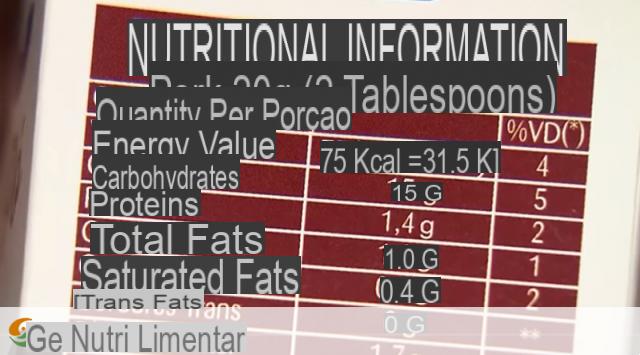
labels food: what do you do with it? You read them to look for ingredients you are allergic to or just the calories contained? Or you ignore them because always buy the same products do you trust? In any case, it might be useful to start as well read the back of the packages, to find out what the foods we consume every day really contain. They might not all be nice surprises ...
Let's start by trying to learn more about the nutritional values: what is it about?
Nutritional values on labels: what it is
The indications on the nutritional values on the label are mandatory for packaged foods. There is a very specific regulation regarding food labels: what must be indicated, which messages can be written and which cannot.
According to the EU Regulation n. 1169/2011, the declared values are i average values established. The average value is defined as that value which, according to the aforementioned Regulation, "best represents the quantity of a nutrient contained in a given food and which takes into account the tolerances due to seasonal variations, consumption habits and other factors that may influence the actual value ".
There are few exceptions where they can come omitted the indications of nutritional values, for instance:
> Foods sold in bulk, without pre-packaging or packaged at the points of sale at the request of the consumer or pre-packaged for direct sale;
> foods with small packaging or containers, whose largest surface measures less than 10 square cm;
> drinks with alcohol content higher than 1,2% by volume;
> unprocessed products which include a single ingredient or a single category of ingredients;
> processed products that have been subjected only when ripe and which include a single ingredient or a single category of ingredients;
> the water intended for human consumption, including those that contain carbon dioxide and / or flavorings as the only added ingredients.
> the aromas, that is: aromatic plants, spices or their mixtures; salt and salt substitutes; table-top sweeteners; the aromas; fermentation vinegars and their substitutes;
> You e coffee, that is: whole or ground coffee beans and whole or ground decaffeinated coffee beans; herbal and fruit infusions, teas, decaffeinated teas, instant or soluble teas or tea extracts, decaffeinated instant or soluble teas or tea extracts, with no added ingredients other than flavorings which do not affect the nutritional value of the tea;
> all food additives, processing aids, food enzymes; gelatine and gelation compounds for jams; yeasts; chewing gum.
> food, also packaged in an artisanal way, supplied in small quantities of products to the final consumer.
Read also Nutritional values and nutraceutical foods >>
Nutritional values: what it is. What information is mandatory?
The nutritional values shown on the label concern the amount of carbohydrates, proteins and fats that make up a particular food expressed in quantity / 100 gr.
In addition to the three main macronutrients mentioned above, they are indicated the calories of a food, the percentages of vitamins, mineral salts, water, fiber, sugars and their chemical composition. Often the percentages of each individual substance are also reported, referring to the recommended daily dose (RDA).
Here are the Required Information which must appear as nutritional values:
> valore energetico: expressed in kcal and kJ. They are the calories produced by the food;
> ccarbohydrates: any carbohydrate metabolized by man, including polyols (alcohols comprising more than two hydroxyl groups) and sugars (all monosaccharides and disaccharides) present;
> fat: i total lipids. They are included all subgroups of fatty acids: 'Saturated fatty acids' means fatty acids which do not have double bonds; 'Trans fatty acids' means fatty acids which have at least one double bond carbon atoms in the trans configuration; 'Monounsaturated fatty acids': fatty acids with a cis double bond; 'Polyunsaturated fatty acids': fatty acids with two or more double bonds interrupted by cis-cis methylene groups;
> salt: the salt content is calculated using the formula: salt = sodium × 2,5. Eventually there may be a statement indicating that the salt content is due exclusively to the naturally present sodium.
Nutritional values: What are the optional information?
There is also a number of information that may appear at the manufacturer's discretion to complement the nutritional information. Here are the main optional information:
> monounsaturated fatty acids: fatty acids with cis double bond;
> polyunsaturated fatty acids: fatty acids with two or more double bonds interrupted by cis-cis methylene groups;
> polyol: alcohols comprising more than two hydroxyl groups;
> starch;
> fibers: they are composed of three or more carbohydrate units and are neither digested nor absorbed by the human intestine and belong to one of the following categories: 1) edible carbohydrate polymers naturally present in food, 2) edible carbohydrate polymers obtained from raw materials food by physical, enzymatic or chemical processes and which have a beneficial physiological effect demonstrated by generally accepted scientific data; 3) edible synthetic carbohydrate polymers which have a beneficial physiological effect demonstrated by generally accepted scientific data;
> i mineral salts o Vitamins if present in significant quantities. Normally, to decide whether a quantity is significant for each 100 g or 100 ml or for each package, if it contains only one portion, 15% of the recommended daily dose is taken as a “minimum significant amount”.
Read also The law and the label of organic foods >>


























